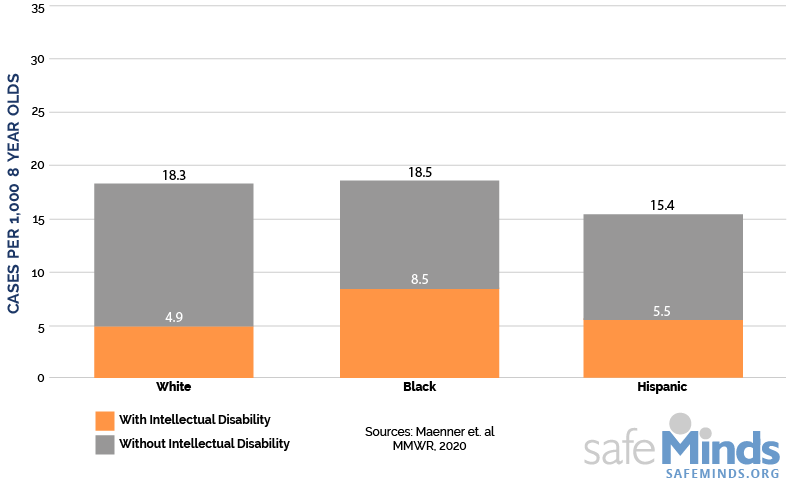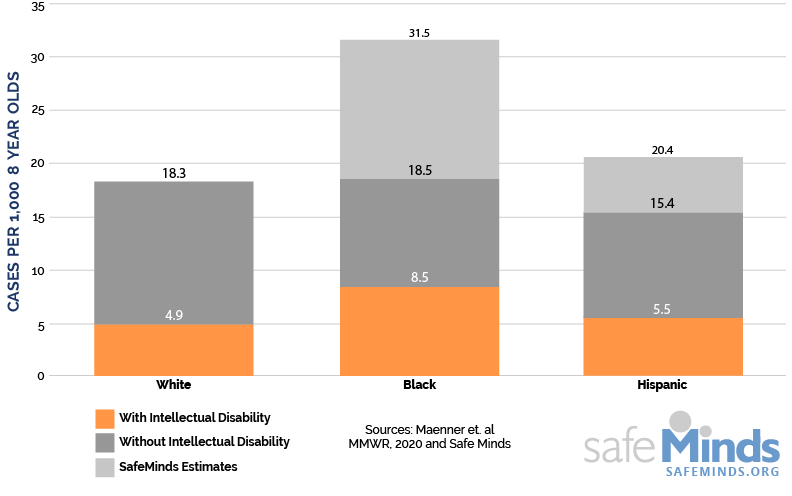New Official Rate is 1 in 54, up 10% Since Last Report
Progress Lacking in Early Diagnosis, Racial & Ethnic Disparities Found
The Centers for Disease Control and Prevention (CDC) released its latest prevalence estimates for autism. It reports 1 in 54 children have an autism spectrum disorder (ASD). The rate is an increase of 10% from two years ago, when the figure was 1 in 59 children. The new prevalence reflects a 2.76 fold jump in numbers since the CDC began collecting data in 2000.
“It is surprising that the prevalence of a significant disorder like autism has risen so consistently over a relatively brief period of time,” stated Walter Zahorodny Ph.D., the director of the CDC’s New Jersey autism monitoring site, in a press release issued by Rutgers-New Jersey Medical School. “Changes in awareness, shifts in how children are identified or diagnosed, factors related to awareness are relevant, but only take you so far in accounting for an increase of this magnitude. We don’t know what is driving the surge in autism recorded by the ADDM Network and others.”
The study was published in the CDC publication Morbidity & Mortality Weekly Report. It identified 18.5 cases of autism per 1,000 children aged 8 years across 11 communities comprising the Autism and Developmental Disabilities Monitoring Network (ADDM). The prevalence means almost 2% of American 8 year olds have this condition.
More boys continued to be identified than girls, with a ratio of 4.3:1. Most cases (58%) had intellectual challenges, with 33% classified as having intellectual disability, defined as an IQ of 70 or less, and 24% having an IQ in the borderline range (IQ 71–85). The remainder (42%) had IQ in the average or higher range (IQ >85).
Individuals with lower intellectual functioning face poorer outcomes and require more supports across the lifespan than those with normal IQs. They comprise the largest share of the $285+ billion annual cost of autism in the U.S.
Missing Cases
The CDC study likely under-reports the overall true autism prevalence because several of its surveillance sites lack access to adequate records.
The ADDM collected its data 4 years ago (2016). The 8 year olds monitored were born in 2008. The 11 communities covered portions of Arizona, Arkansas, Colorado, Georgia, Maryland, Minnesota, Missouri, New Jersey, North Carolina, Tennessee, and Wisconsin. The communities cover less than 10% of the U.S. population of 8 year olds and are not representative of the U.S. population.
Wide variability in prevalence was reported by site, ranging from 13.1 (1 in 76) in Colorado to 31.4 (1 in 32) in New Jersey. To calculate prevalence, the ADDM investigators reviewed the medical and education records in their respective communities and determined which children had a diagnosis of autism or met the criteria for such a diagnosis based on information in the record. The variability reflects the uneven ability to find cases based on the quality of the records of each community.
Not all communities permit access to full educational records to researchers which causes the rate of autism in those areas to be underreported. For example, two sites with limited access (Colorado and Missouri) had the lowest prevalence in the Network (13.1 and 13.6 respectively). Some sites had access to records with extensive information (such as New Jersey) and others had records with sparse information. The more robust the record, the more likely a true case can be identified.
Continued Shortcomings in Timely Diagnoses
The median age of autism diagnosis was 51 months. Despite recognition by health officials that early diagnosis is critical to optimal outcomes, the median age has not changed since 2010. Fewer than half of the 8 year olds (44%) had been evaluated by a professional by age 36 months, which is the age that the vast majority of children will have exhibited clear symptoms of autism. One quarter (24%) of the children identified by the ADDM researchers as meeting the criteria for autism were lacking any diagnosis at all by age 8.
An evaluation and diagnosis are vital to receiving needed specialized supports. Without a timely diagnosis, vulnerable children will miss out on early intensive interventions when the brain is most responsive to therapy.
Racial & Ethnic Disparities
The study also found racial and ethnic disparities in prevalence and IQ. The overall prevalence of white, black, and Asian children were roughly similar (18.5, 18.3, and 17.9 per 1,000, respectively), but Hispanics were lower (15.4).
A much higher proportion of the black and Hispanic children with ASD were classified as having intellectual disability (ID) than the ASD children who were white (47%, 36%, and 27%, respectively – see Figure 1). The authors state that “black and Hispanic children with autism who do not have intellectual disability might not be identified at the same rates as white children.”
Fig. 1: Autism Prevalence by Race/Ethnicity and IQ

If black or Hispanic ASD children with higher IQs were diagnosed at the same rate as white children, their overall prevalence would be much higher than what is reported in the CDC study, as shown in the SafeMinds estimations in Figure 2. These estimations are consistent with recent studies (Nevison and Parker 2020 and Nevison and Zahorodny 2019<) showing that prevalence for black and Hispanic children is surpassing that of white children, particularly white children residing in more affluent areas. The implications of these trends are examined in last week’s SafeMinds Shares.
“An alternative explanation for the high rate of intellectual disability in black and Hispanic children might be that they are being more heavily impacted by harmful environmental exposures that raise the risk for severe autism,” suggests autism researcher Cynthia Nevison of the University of Colorado. “Both explanations might be relevant.”
Black and Hispanic children have almost closed the gap when it comes to age of first evaluation and diagnosis. The median age of receiving a comprehensive evaluation was 39 months for white, 42 months for black and 40 months for Hispanic children. The percentage of children with ASD evaluated by age 36 months was 45% among white children, 43% among Hispanic children, and 40% among black children. The median age of diagnosis was 51 months for white children, 53 months for black children and 51 months for Hispanic children.
Fig. 2: Autism Prevalence by Race/Ethnicity and IQ, with Estimates of Overall Prevalence if Higher IQ Rates for Black & Hispanic are the Same as White Children

CDC Recommendations
In its press release accompanying the study publication, the CDC’s single recommendation leaves it to parents to “learn the signs” of autism so they can seek an earlier diagnosis and get services. Parents can visit www.cdc.gov/ActEarly to find out how. No recommendations were made by the agency to improve system-level access to diagnostic services and evidence-based interventions by parents.
While recognizing autism as a “public health concern”, the CDC offered no definitive answers on why autism rates keep rising. At a rate of 1 in 54, at least 75,000 American children per year are being diagnosed with what is generally a lifelong condition accompanied by significant disability and higher health morbidities and mortality.
References
Rutgers Media Department. Autism Prevalence Rises Again in Communities Monitored by CDC. March 26, 2020
Matthew J. Maenner, Kelly A. Shaw, Jon Baio et al. Prevalence of Autism Spectrum Disorder Among Children Aged 8 Years — Autism and Developmental Disabilities Monitoring Network, 11 Sites, United States, 2016. MMWR Surveillance Summaries / Vol. 69 / No. 3. March 27, 2020.
Autism Speaks. Autism Statistics and Facts. Accessed March 26, 2020.
Cynthia Nevison, William Parker. California Autism Prevalence by County and Race/Ethnicity: Declining Trends Among Wealthy Whites, Journal of Autism and Developmental Disorders (2020). DOI: 10.1007/s10803-020-04460-0
SafeMinds. Socioeconomic & Racial Divide in Autism Numbers. SafeMinds Shares. March 23, 2020.
CDC Media Relations. Autism Prevalence Rises in Communities Monitored by CDC. March 26, 2020.


